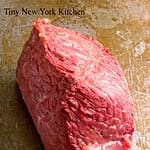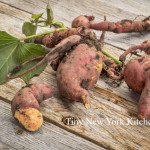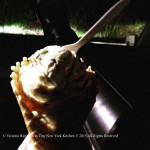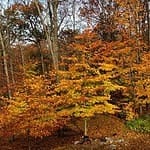It’s that time of year again, in America, when the beer turns green and the aroma of corned beef and cabbage fills the air. The dish is so comforting, but just what is corned beef? The term has nothing to do with corn, but was the English term for a small granule, such as a grain of salt. In days before modern refrigeration, salting meat was a way to preserve it and keep it from spoiling.
Corned beef is an Americanized addition to the traditional Irish diet. While colcannon (boiled potatoes, cabbage, and leeks in buttermilk flavored with wild garlic) was a common Irish dish, as was brown soda bread, corned beef was produced primarily for export to England. Upon arriving in America, however, it’s thought the Irish chose to celebrate their holiday with food that was typically not available to them in their home country, so corned beef was added to the menu, as was white soda bread studded with currants and caraway.
Corned beef is typically made from beef brisket, which is a cut of meat from the breast or lower chest, but the rump, bottom round, and even tongue, can be used. In America, the term “corned beef” is used to describe both the cured meat and the canned stuff found on grocery store shelves. In Britain, they call the canned stuff “salt beef.”
To make corned beef the meat is simmered in a blend of corned beef spices that usually include peppercorns, garlic, mustard, tarragon, thyme, parsley, cloves, and nutmeg.
In New England, you most often see corned beef served as a St. Patrick’s Day main dish or in a sandwich. As the main ingredient in New England Boiled Dinner, corned beef often pairs with potatoes, carrots, turnips, and cabbage in a hearty, savory, brothy bowl of goodness. When used in a sandwich, the most popular corned beef sandwich is the Reuben. Considered the quintessential Jewish deli sandwich, a Reuben is toasted rye bread stuffed with hot slices of corned beef, usually piled high, and topped with sauerkraut, Swiss cheese, and either Russian or Thousand Island dressing.
In New England, a frequent point of interest is also whether you prefer red vs. gray corned beef. The difference is “Red” brisket is cured with nitrite, which gives the meat its signature color. “Gray” corned beef, which is considered the authentic New England variety, is not cured with nitrate, so color forms naturally as it brines.
If you have corned beef leftovers a New England favorite is corned beef hash, which is typically served for breakfast.
“Work With What You Got!”
©Tiny New York Kitchen © 2018 All Rights Reserved
I love shopping at autumn farm markets and am currently planning the Thanksgiving meal. I love shopping for local and seasonal produce. God Bless local farmers!
Even though summer is not technically over I’m in the fall baking mood. Yesterday was a rainy day here in New England. I made Gooey Rocky Road Brownies and I had to stop myself from eating the entire batch.
Family & Thanksgiving
More than any other holiday, Thanksgiving has evolved as a time to gather together. On Christmas most Americans stay at home, but on Thanksgiving, many pack up and leave home to spend the holiday with relatives and friends. This is nearly as old a custom of the day as having turkey and pumpkin pie.
The reunion tradition arose in the early eighteenth century as families began dispersing across New England to settle on the frontiers of New England (western Massachusetts, Vermont, New Hampshire, and Maine). Gradually, before and after the Revolutionary War, New Englanders pressed into New York State, Ohio, and even parts of the southern colonies and territories. In the nineteenth century, hundreds of New Englanders went west during the Gold Rush and subsequent westward migrations. And as Boston, New York, and other towns grew into cities, young people left farms to join businesses or to work in industries in urban centers. Thanksgiving was the time people chose for family reunion, to go back to the old homestead for a visit. It still is.
“Work With What You Got!”
© Victoria Hart Glavin Tiny New York Kitchen © 2016 All Rights Reserved
The New England weather has turned. This weekend I had to put away my beloved sandals and search out my colder weather boots. Yesterday it even snowed a bit and it’s not even Halloween! The creamery closes October 30th, which prompted me to get my last licks in this weekend.
“Work With What You Got!”
© Victoria Hart Glavin Tiny New York Kitchen © 2015 All Rights Reserved
Such A Beautiful Sunday Fall Morning!













